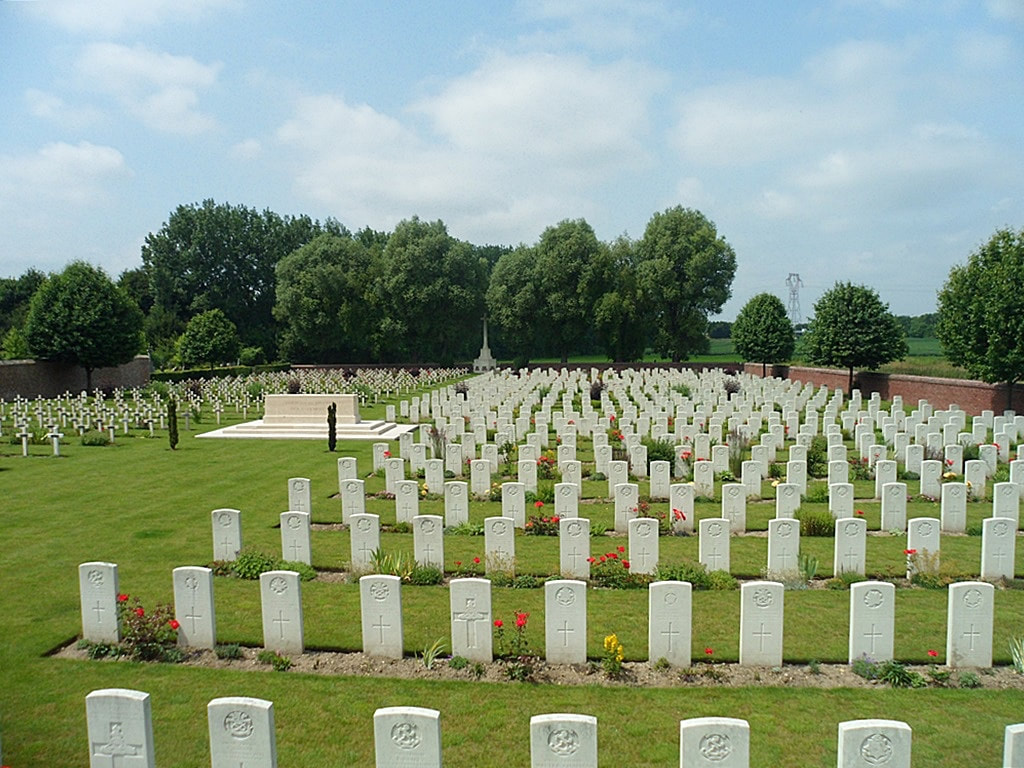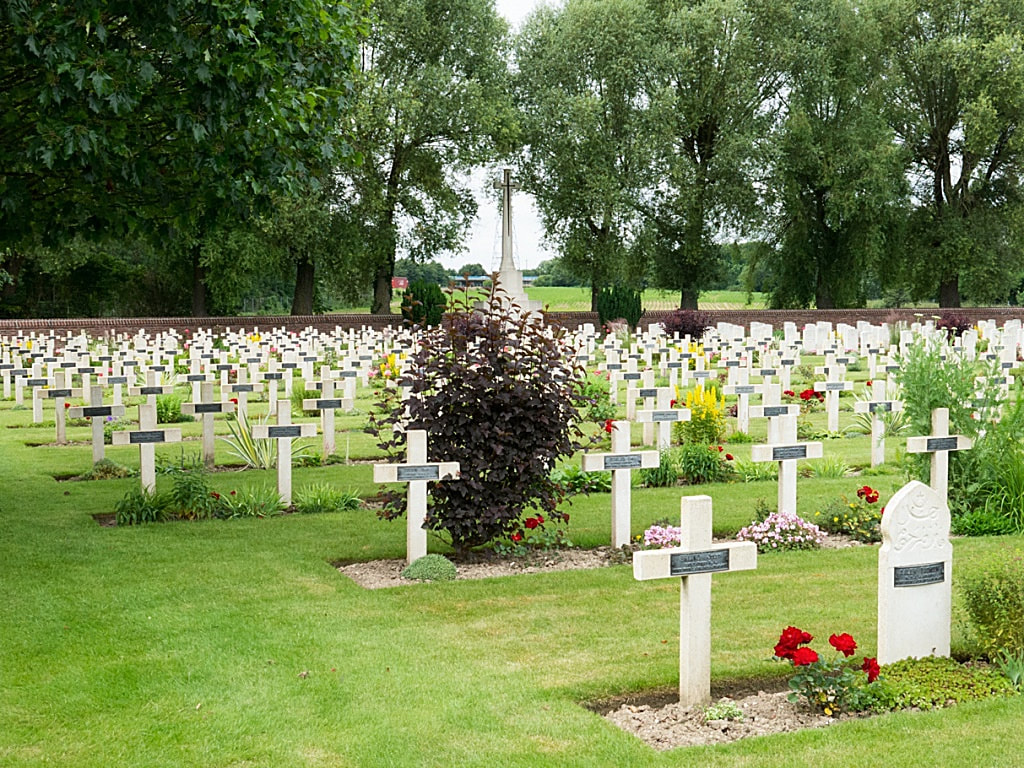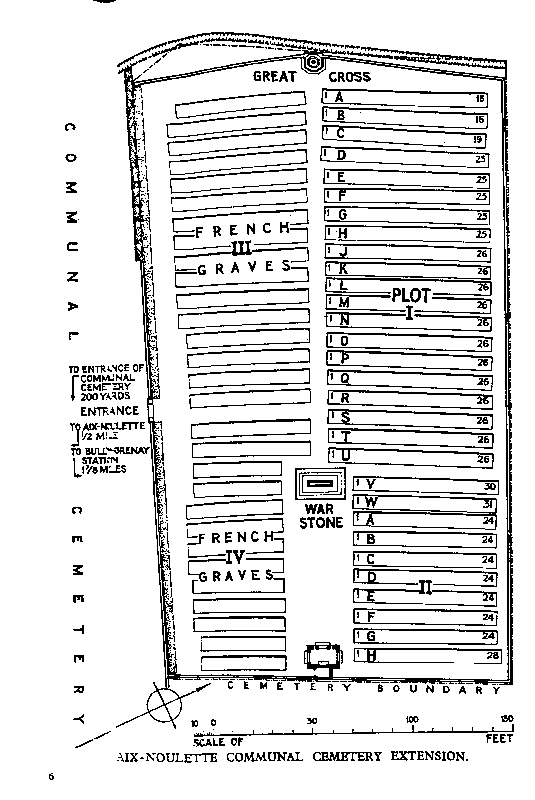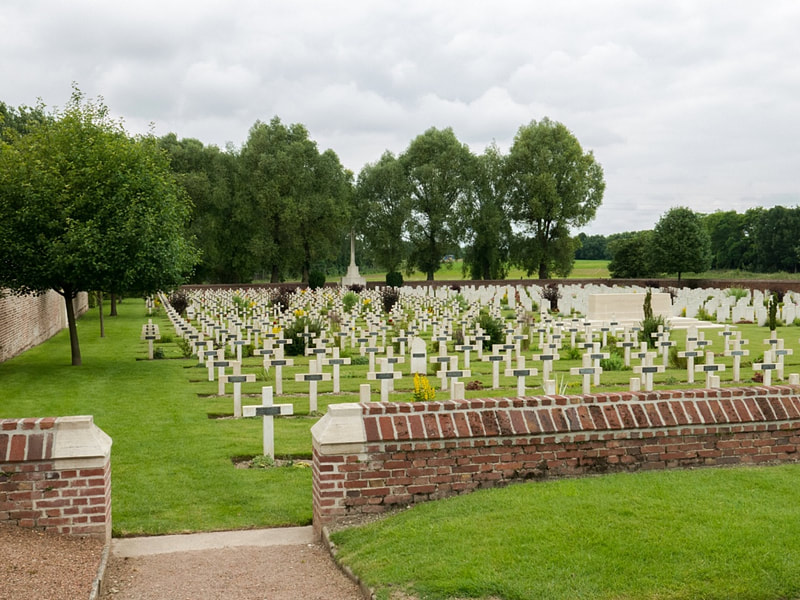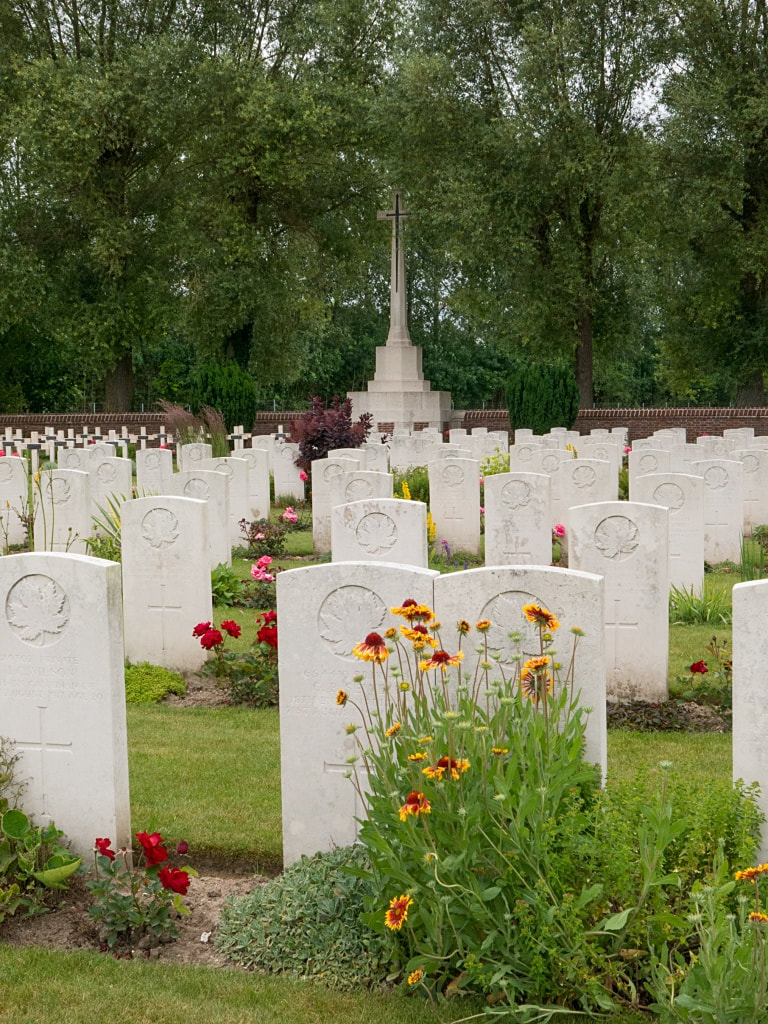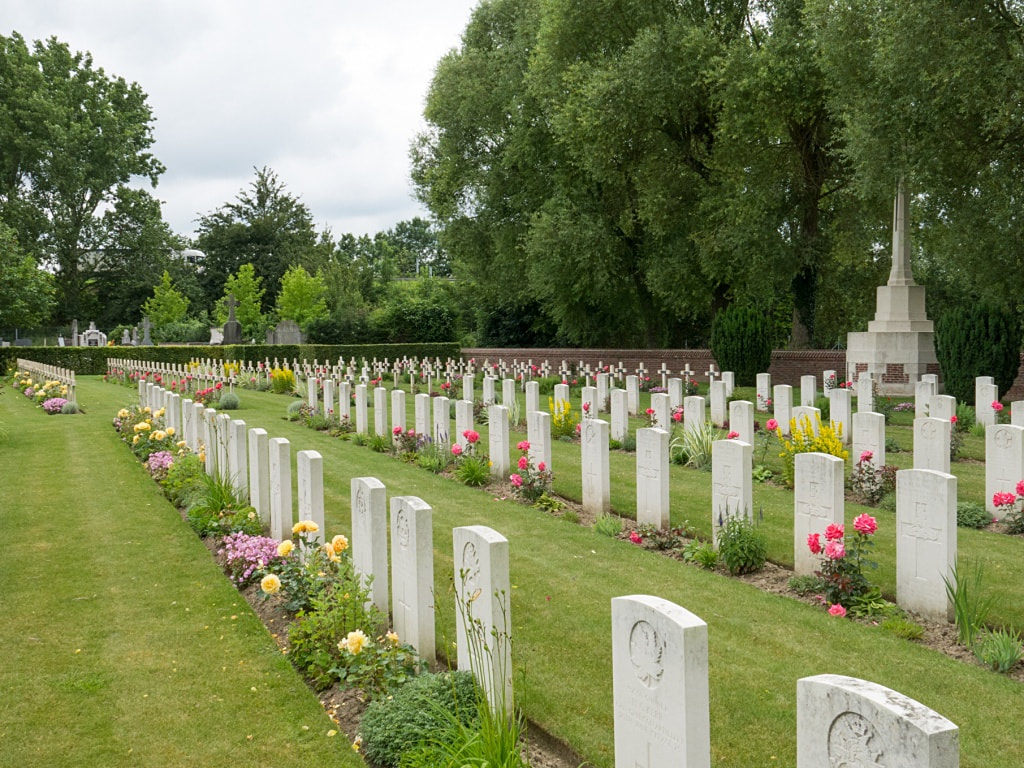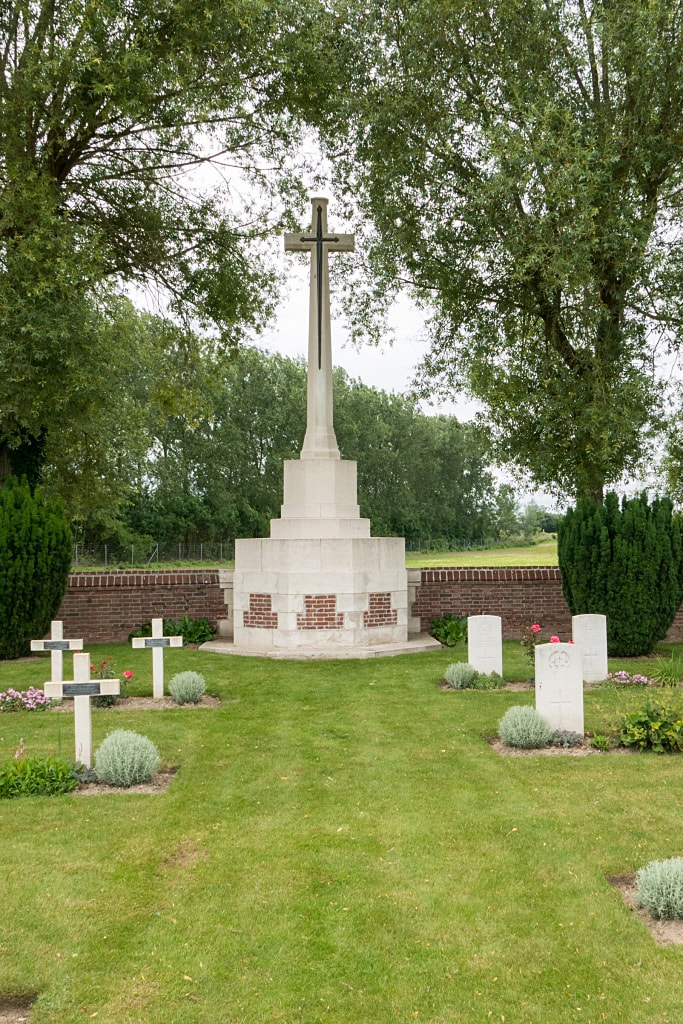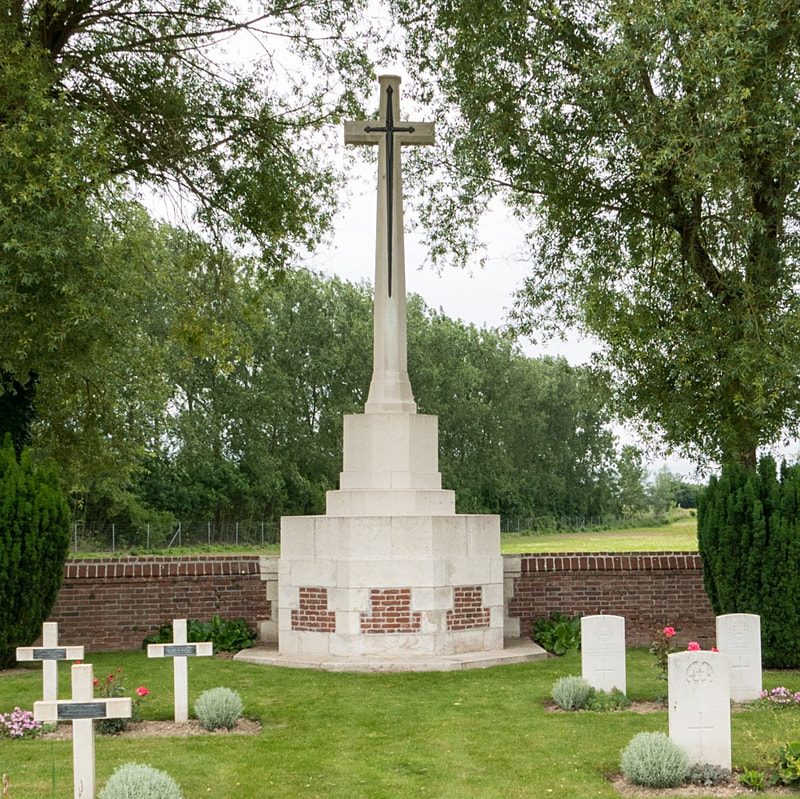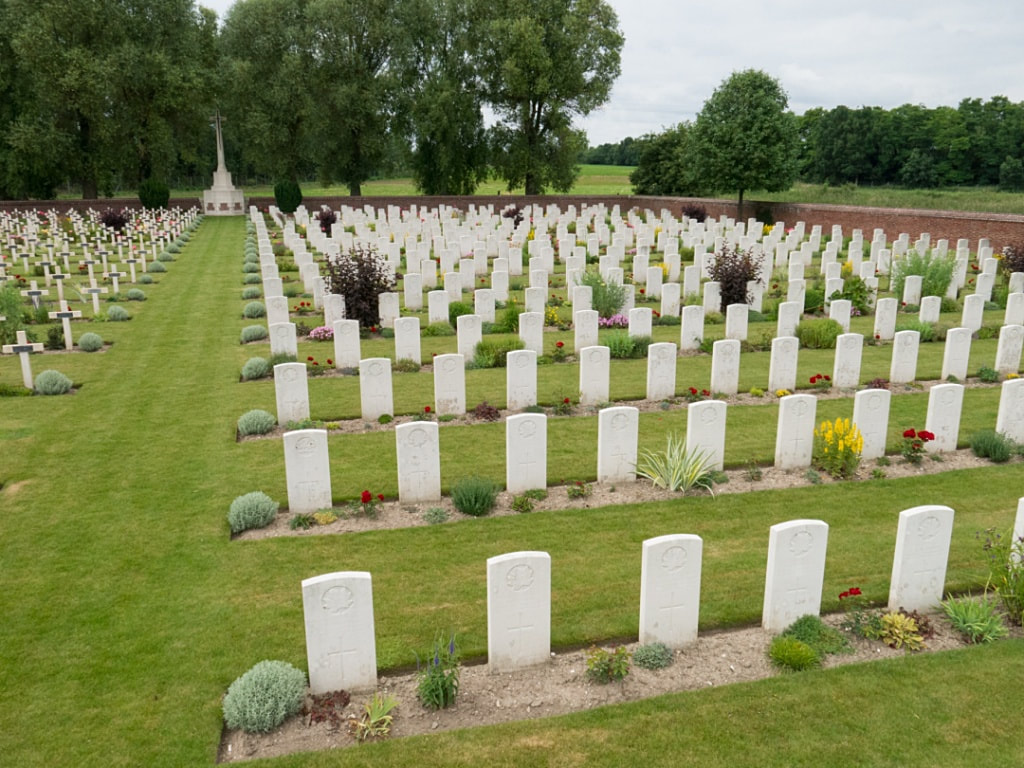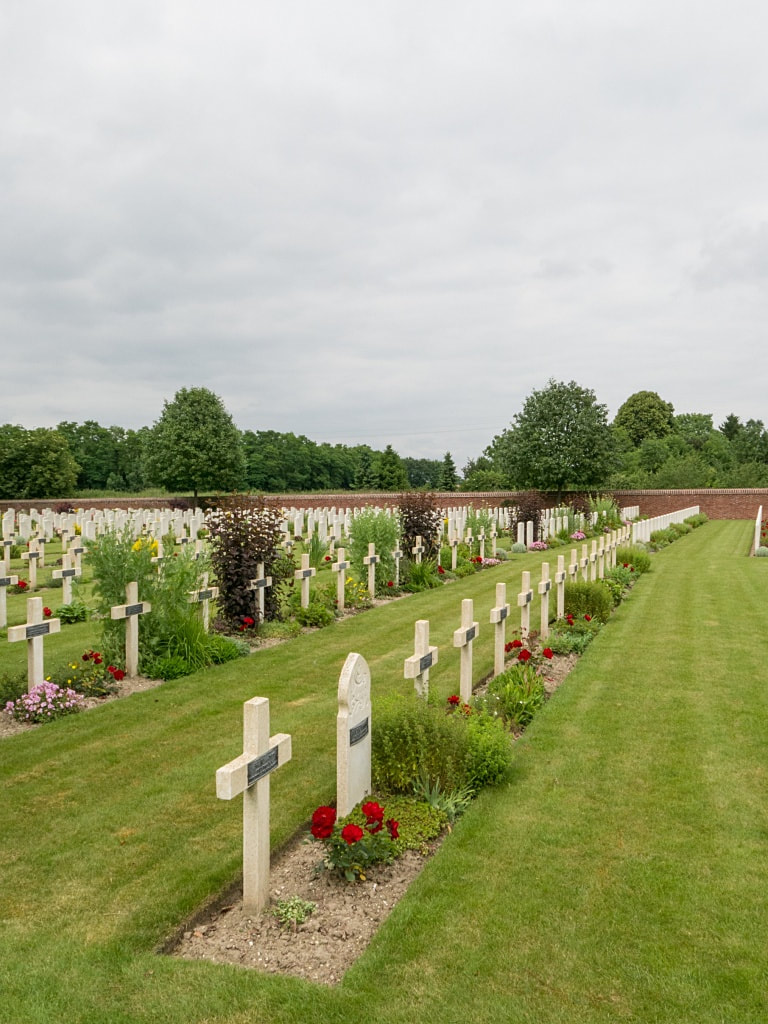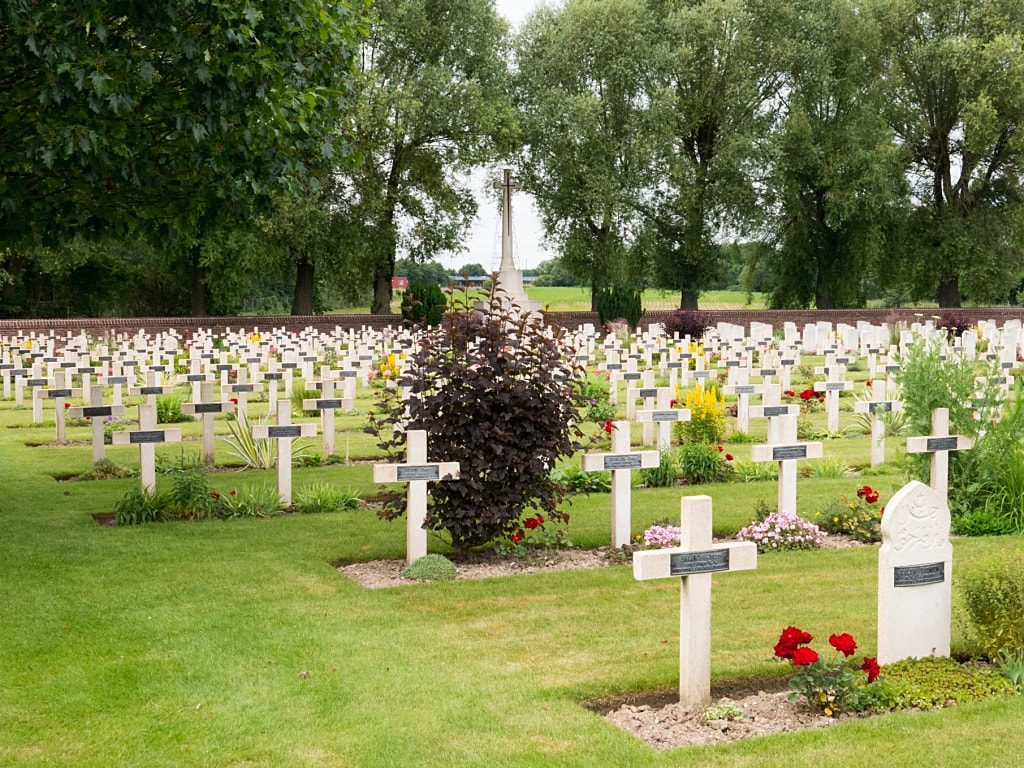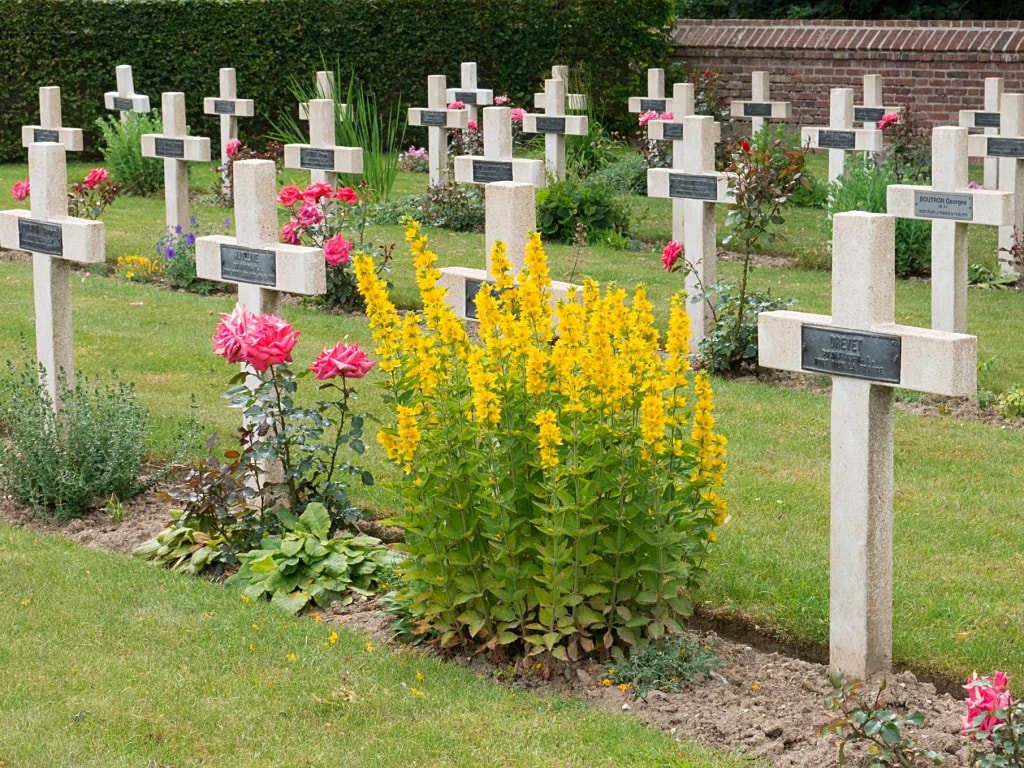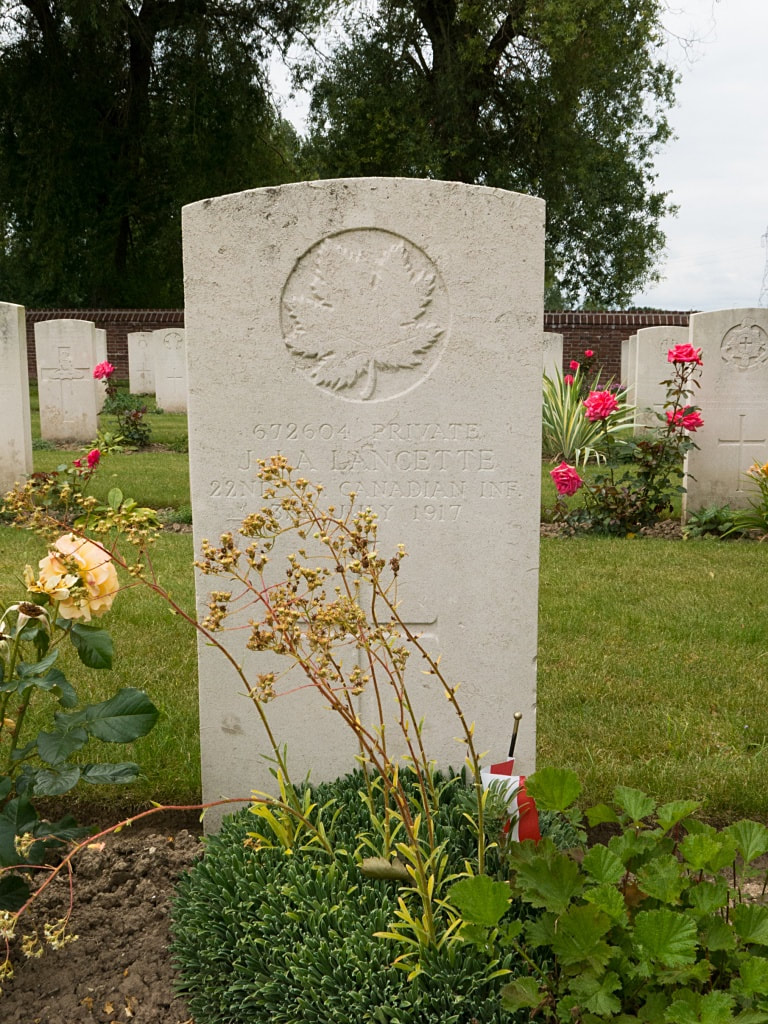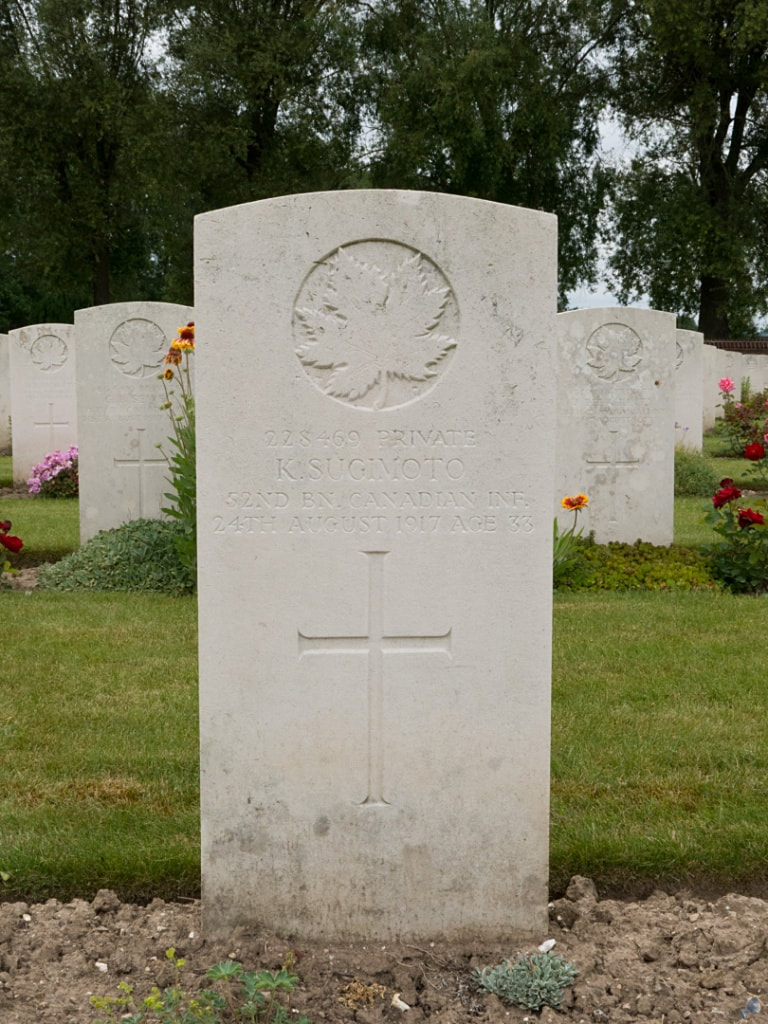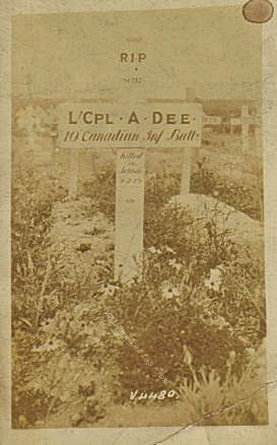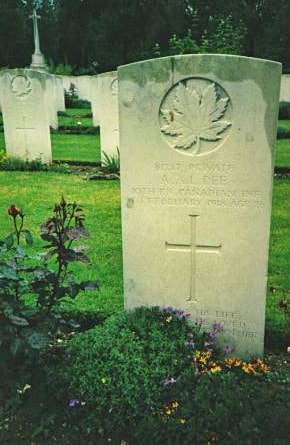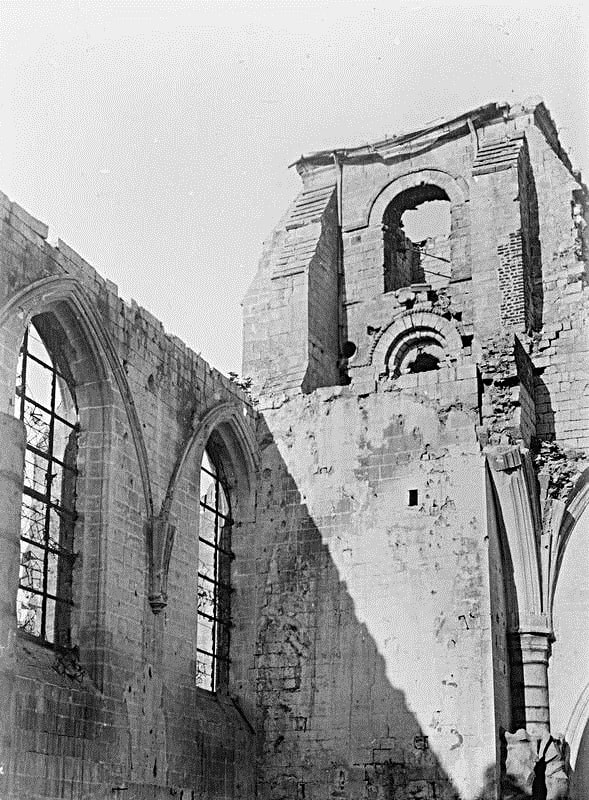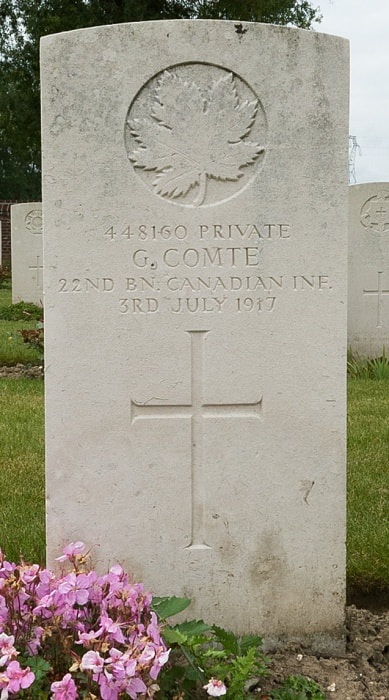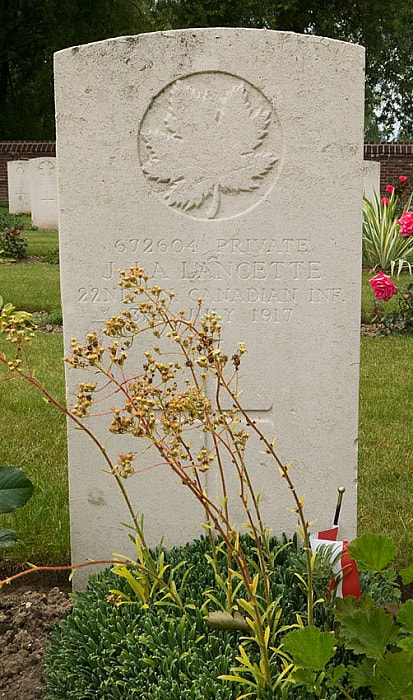AIX-NOULETTE COMMUNAL CEMETERY EXTENSION
Pas De Calais
France
GPS Coordinates: Latitude: 50.43106, Longitude: 2.71223
Location Information
Aix-Noulette is a village in the Department of the Pas-de-Calais, about 13 kilometres south of Bethune on the main road to Arras. From Arras take the D937 towards Bethune. At Aix-Noulette, turn right at the church. The Communal Cemetery and Extension are a few hundred metres on the left side of the road to Bully-Grenay.
Visiting Information
Wheelchair access possible via main entrance.
Historical Information
The Cemetery Extension was begun by French troops early in 1915, and the two French plots are next to the Communal Cemetery. It was taken over by the 1st and 2nd Divisions in February, 1916, and used by fighting units and Field Ambulances until October, 1918. It was increased after the Armistice by the concentration of graves from the battlefields to the East.
There are now 749 Commonwealth burials of the 1914-1918 war commemorated here, 61 are unidentified. There are also 502 French burials here.
The cemetery covers an area of 5,198 square metres and is enclosed by a red brick wall on three sides, and on the South by the wall of the Communal Cemetery.
Total Burials: 1,252.
Commonwealth Identified Casualties: Canada 482, United Kingdom 206. Total 688.
Unidentified Casualties: United Kingdom 51, Canada 10. Total 61.
Other Nationalities: France 502.
The cemetery was designed by Sir Edwin Lutyens & Arthur James Scott Hutton
Images in gallery below © Werner Van Caneghem
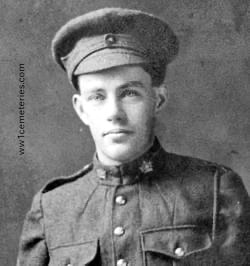
880497 Private
David Aikin
18th Bn. Canadian Infantry
21st August 1917, aged 24.
Plot I. M. 12.
Son of David and Jane Aikin; husband of Myrtle Fitzpatrick Loop (formerly Aikin), of Wheatley, Ontario. Born at Belfast, Ireland.
His headstone bears the inscription "Thy Will Be Done"
David Aikin
18th Bn. Canadian Infantry
21st August 1917, aged 24.
Plot I. M. 12.
Son of David and Jane Aikin; husband of Myrtle Fitzpatrick Loop (formerly Aikin), of Wheatley, Ontario. Born at Belfast, Ireland.
His headstone bears the inscription "Thy Will Be Done"
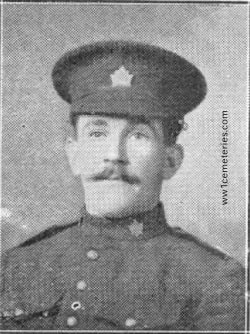
907545 Corporal
James Allan, M. M.
5th Bn. Canadian Infantry
12th March 1918.
Plot II. C. 6.
James Allan, M. M.
5th Bn. Canadian Infantry
12th March 1918.
Plot II. C. 6.
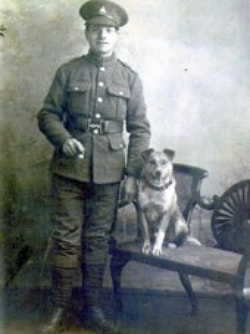
G/14393 Private
Charles Leonard Bennett
9th Bn. Royal Sussex Regiment
Died between 12th April 1917 and 13th April 1917, aged 19.
Plot I. E. 22.
Son of Samuel James and Mary Elizabeth Bennett, of 16, Prospect Row, Woolwich, London.
His headstone bears the inscription "Thy Will Be Done"
This soldier was officially registered as Charles Leonard Bennett although his actual name was actually Leonard Charles Bennett. The reason for the change being that Leonard had been nicknamed ‘Elsie’ at school because of his initials. Not wishing to be known as ‘Elsie’ in the army, the enterprising lad turned his names around! Because his elder brother Albert (my father) had joined up, he tried to enlist at the age of 16, but his fib was discovered and he was sent home. When he reached the correct age for enlistment, he joined the Royal Sussex, and was sadly killed near Arras in April 1917 at the age of 19.
Picture courtesy of his nephew, Derek Bennett
Charles Leonard Bennett
9th Bn. Royal Sussex Regiment
Died between 12th April 1917 and 13th April 1917, aged 19.
Plot I. E. 22.
Son of Samuel James and Mary Elizabeth Bennett, of 16, Prospect Row, Woolwich, London.
His headstone bears the inscription "Thy Will Be Done"
This soldier was officially registered as Charles Leonard Bennett although his actual name was actually Leonard Charles Bennett. The reason for the change being that Leonard had been nicknamed ‘Elsie’ at school because of his initials. Not wishing to be known as ‘Elsie’ in the army, the enterprising lad turned his names around! Because his elder brother Albert (my father) had joined up, he tried to enlist at the age of 16, but his fib was discovered and he was sent home. When he reached the correct age for enlistment, he joined the Royal Sussex, and was sadly killed near Arras in April 1917 at the age of 19.
Picture courtesy of his nephew, Derek Bennett
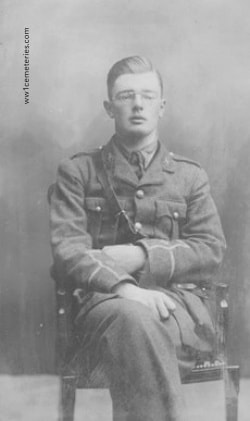
Lieutenant
William Dobree Chepmell
9th Bn. Royal Sussex Regiment, attached to Trench Mortar Battery
12th April 1917, aged 21.
Plot I. E. 20.
Son of Charles and Mary Chepmell.
His headstone bears the inscription "Now Is Christ Risen From The Dead In Christ Shall All Be Made Alive"
William Dobree Chepmell
9th Bn. Royal Sussex Regiment, attached to Trench Mortar Battery
12th April 1917, aged 21.
Plot I. E. 20.
Son of Charles and Mary Chepmell.
His headstone bears the inscription "Now Is Christ Risen From The Dead In Christ Shall All Be Made Alive"
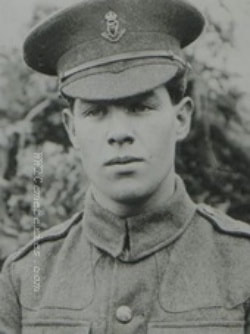
81217 Private
Archibald Adolphus Louis Dee
10th Bn. Canadian Infantry
9th February 1918, aged 26.
Plot I. S. 20.
Son of Mary A. E. Dee, of 65, Clive Rd., Fratton, Portsmouth, England, and the late Joseph A. Dee. Born at Kingstanley, Stonehouse, Glos., England.
His headstone bears the inscription "He Gave His Life For Those He Loved From His Loving Mother"
Archie was born in Jersey Channel Islands on May 9th 1891 and was the son of Joseph and Mary Dee of King Stanley, Gloucestershire.
Along with a brother and two sisters he emigrated to Canada and was working as a farmer when he enlisted in Winnipeg on 16th December 1914 to serve in the Canadian Over-Seas Expeditionary Force with the 32nd Battalion.His description on enlistment was 5ft 9ins tall, with brown eyes and dark brown hair.
He transferred to the 10th Battalion on 26th April 1915 and was then in France leaving Halifax on S.S. Vaderland on 23 February 1915. From 26th may until 16th June he was treated for gas injuries and regained his unit on 31st July 1915.
On 22nd April 1916 he was again injured. This time it was a wound to the shoulder and he took leave in the UK landing at Folkestone on 26th April 1916. He spent time at hospitals in Woodcote Park, Epsom and Taplow before going back to France on 24th April 1917.
He was killed in action on 9th February 1918 and is buried at Aix-Noulette.His widowed mother received a separation allowance and a War Gratuity of $180 which was twelve months pay @ $15 per month from the Canadian authorities in 1920.
Note: As can be seen in the images below, the original cross erected showed Archie as a Lance Corporal, the CWGC show him to be a Private.
Archibald Adolphus Louis Dee
10th Bn. Canadian Infantry
9th February 1918, aged 26.
Plot I. S. 20.
Son of Mary A. E. Dee, of 65, Clive Rd., Fratton, Portsmouth, England, and the late Joseph A. Dee. Born at Kingstanley, Stonehouse, Glos., England.
His headstone bears the inscription "He Gave His Life For Those He Loved From His Loving Mother"
Archie was born in Jersey Channel Islands on May 9th 1891 and was the son of Joseph and Mary Dee of King Stanley, Gloucestershire.
Along with a brother and two sisters he emigrated to Canada and was working as a farmer when he enlisted in Winnipeg on 16th December 1914 to serve in the Canadian Over-Seas Expeditionary Force with the 32nd Battalion.His description on enlistment was 5ft 9ins tall, with brown eyes and dark brown hair.
He transferred to the 10th Battalion on 26th April 1915 and was then in France leaving Halifax on S.S. Vaderland on 23 February 1915. From 26th may until 16th June he was treated for gas injuries and regained his unit on 31st July 1915.
On 22nd April 1916 he was again injured. This time it was a wound to the shoulder and he took leave in the UK landing at Folkestone on 26th April 1916. He spent time at hospitals in Woodcote Park, Epsom and Taplow before going back to France on 24th April 1917.
He was killed in action on 9th February 1918 and is buried at Aix-Noulette.His widowed mother received a separation allowance and a War Gratuity of $180 which was twelve months pay @ $15 per month from the Canadian authorities in 1920.
Note: As can be seen in the images below, the original cross erected showed Archie as a Lance Corporal, the CWGC show him to be a Private.
Ruins of Aix-Noulette Church. August-September 1916. © IWM (Q 14749)
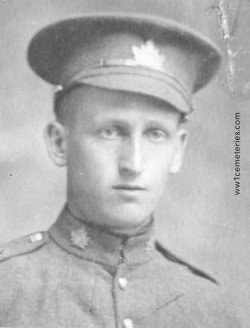
868434 Private
Charlie Foster
116th Bn. Canadian Infantry
19th April 1918, aged 25.
Plot II. F. 8.
Son of Thomas and Louisa M. Foster, of 204, Celina St., Oshawa, Ontario.
His headstone bears the inscription "Christ Died For Me"
Charlie Foster
116th Bn. Canadian Infantry
19th April 1918, aged 25.
Plot II. F. 8.
Son of Thomas and Louisa M. Foster, of 204, Celina St., Oshawa, Ontario.
His headstone bears the inscription "Christ Died For Me"
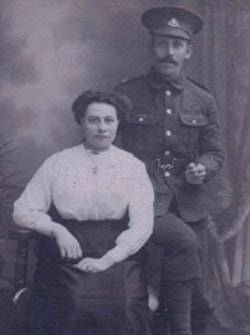
307709 Private
Thomas Grosse
1st/8th Bn. Sherwood Foresters (Notts and Derby Regiment)
23rd June 1917, aged 33.
Plot I. F. 17.
Husband of Mrs I Grosse, of Newark
Thomas was one of three brothers to lay down their lives in the Great War. The other two are Alfred who died on 2nd May 1918, aged 21 and is buried in Sandpits British Cemetery in France and Joseph who died on 2nd December 1918, aged 19 and is buried in Grevillers British Cemetery, also in France.
Picture courtesy of Pete Stevens
Thomas Grosse
1st/8th Bn. Sherwood Foresters (Notts and Derby Regiment)
23rd June 1917, aged 33.
Plot I. F. 17.
Husband of Mrs I Grosse, of Newark
Thomas was one of three brothers to lay down their lives in the Great War. The other two are Alfred who died on 2nd May 1918, aged 21 and is buried in Sandpits British Cemetery in France and Joseph who died on 2nd December 1918, aged 19 and is buried in Grevillers British Cemetery, also in France.
Picture courtesy of Pete Stevens
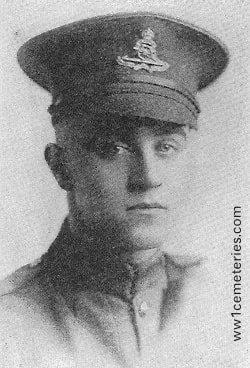
339312 Driver
Donald Beresford Hope
5th Brigade, Canadian Field Artillery
13th August 1917, aged 21.
Plot I. G. 24.
Son of Frederick Beresford Hope and Anna A. Hope, of 65, Caroline Court, Vancouver, British Columbia.
Donald Beresford Hope
5th Brigade, Canadian Field Artillery
13th August 1917, aged 21.
Plot I. G. 24.
Son of Frederick Beresford Hope and Anna A. Hope, of 65, Caroline Court, Vancouver, British Columbia.

237336 Private
Daniel McPhail
3rd Bn. Canadian Infantry
20th September 1917, aged 24.
Plot I. T. 11.
Son of John and Frances McPhail, of Walkerton, Ontario.
Daniel McPhail
3rd Bn. Canadian Infantry
20th September 1917, aged 24.
Plot I. T. 11.
Son of John and Frances McPhail, of Walkerton, Ontario.
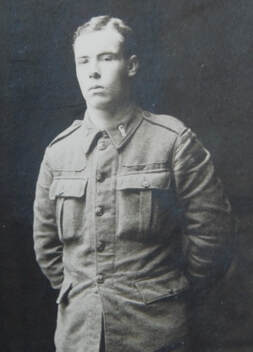
292089 Private
Stanley Perrie
8th Bn. Canadian Infantry
9th March 1918, aged 23.
Plot II. A. 22.
Son of James Perrie, of Treherne, Manitoba, and the late Eliza J. Perrie.
His headstone bears the inscription "He Served His Country Well"
Image and biography provided by Shirley Waldon (Great Niece)
Click on image to enlarge
Stanley Perrie
8th Bn. Canadian Infantry
9th March 1918, aged 23.
Plot II. A. 22.
Son of James Perrie, of Treherne, Manitoba, and the late Eliza J. Perrie.
His headstone bears the inscription "He Served His Country Well"
Image and biography provided by Shirley Waldon (Great Niece)
Click on image to enlarge
Stanley Perrie Biography
Stanley Perrie was born on February 20, 1895 to James and Eliza Perrie in the rural farming community of Treherne, Manitoba, Canada. He was their 3rd child now having joined his older brother Alex born in 1886 and old sister Mary born in 1890. A younger brother John was born in 1899. His mother Eliza died in 1910 and for awhile his sister Mary took over her mother’s role of cooking, cleaning and looking out for her younger brothers until their father James remarried in 1914.
Stanley enlisted in January 1916 at the age of 21. He started out with the 222nd Battalion. Then in November 1916 he sailed from Halifax, Nova Scotia to England onboard the S.S. Olympic – sister ship to the Titanic. After arriving in England, he was transferred to the 8th Battalion, Winnipeg Rifles. After receiving additional training in England, he left for France. In February 1917, he was transferred yet again. This time to the 2nd Canadian Tunnelling Company which was tasked with constructing the tunnels in and around Vimy Ridge as well as other strategic locations in the area. He stayed with this company until mid August 1917 when he rejoined the 8th Battalion Winnipeg Rifles. During his time with the Tunnelling Company he wrote the following entries into his war diary:
v Tuesday, February 20, 1917 - Spent birthday in the trenches;
v Monday, April 8, 1917 - Canadians took Vimy Ridge. Sandy and C. Allen was killed; (They were two of his buddies from his home town of Treherne, Manitoba.)
v Saturday, April 28, 1917 – Canadians took Arlow;
v Thursday, June 7, 1917 - Hill 60. I was in Lilli Gate. Was released the night before. With the 2nd Tunnellers;
v Sunday, July 15, 1917 – Canadians took Hill 70.
v Saturday, July 28, 1917 - went to build a flank road. But was shelled out. And the weather was bad. To go up again with 2nd Tunnellers;
v Monday, August 6, 1917 - Left for the base. Stayed there 2 weeks. Done 10 days at the Bull ring;
v Saturday, August 25, 1917 - Joined the Battalion at Mingoval;
From mid August 1917 through to the end of February 1918, his unit was mostly involved in day-to-day operations in France. However, on November 10, 1917 both the 7th and 8th Battalions were among the Canadian contingent that took Passchendaele. Despite heavy casualties, they seized a battered road junction that included 4 German field guns.
Stanley simply wrote in his war diary: Saturday, Nov. 10, 1917 – We took Passchendaele Ridge. Fine in the morning. Started to rain about 10 o’clock. Dug in with the corp. Coffee and biscuit behind a tree. Got relieved the same night. Left the lump of trench at 6 a.m.
In early March 1918, the 8th Battalion was fighting near the front line near the towns of Bracquemont and Lens. On March 9th they encountered heaving shelling. It was outlined in Stanley’s military record that he was initially listed as being with his unit as there was no record of him being on the casualty list. It was later discovered that he had been seriously wounded and had been transported to the No. 3 Canadian Field Ambulance Depot. It was there that the doctors and nurses discovered that he had sustained multiple shrapnel wounds throughout his body as well as a large skull fracture to the base of his skull. He died of his wounds the next day. He is buried in Aix-Noulette Communal Cemetery northwest of Vimy Ridge near the town of Lens, France along with 481 other Canadian soldiers.
Stanley Perrie was born on February 20, 1895 to James and Eliza Perrie in the rural farming community of Treherne, Manitoba, Canada. He was their 3rd child now having joined his older brother Alex born in 1886 and old sister Mary born in 1890. A younger brother John was born in 1899. His mother Eliza died in 1910 and for awhile his sister Mary took over her mother’s role of cooking, cleaning and looking out for her younger brothers until their father James remarried in 1914.
Stanley enlisted in January 1916 at the age of 21. He started out with the 222nd Battalion. Then in November 1916 he sailed from Halifax, Nova Scotia to England onboard the S.S. Olympic – sister ship to the Titanic. After arriving in England, he was transferred to the 8th Battalion, Winnipeg Rifles. After receiving additional training in England, he left for France. In February 1917, he was transferred yet again. This time to the 2nd Canadian Tunnelling Company which was tasked with constructing the tunnels in and around Vimy Ridge as well as other strategic locations in the area. He stayed with this company until mid August 1917 when he rejoined the 8th Battalion Winnipeg Rifles. During his time with the Tunnelling Company he wrote the following entries into his war diary:
v Tuesday, February 20, 1917 - Spent birthday in the trenches;
v Monday, April 8, 1917 - Canadians took Vimy Ridge. Sandy and C. Allen was killed; (They were two of his buddies from his home town of Treherne, Manitoba.)
v Saturday, April 28, 1917 – Canadians took Arlow;
v Thursday, June 7, 1917 - Hill 60. I was in Lilli Gate. Was released the night before. With the 2nd Tunnellers;
v Sunday, July 15, 1917 – Canadians took Hill 70.
v Saturday, July 28, 1917 - went to build a flank road. But was shelled out. And the weather was bad. To go up again with 2nd Tunnellers;
v Monday, August 6, 1917 - Left for the base. Stayed there 2 weeks. Done 10 days at the Bull ring;
v Saturday, August 25, 1917 - Joined the Battalion at Mingoval;
From mid August 1917 through to the end of February 1918, his unit was mostly involved in day-to-day operations in France. However, on November 10, 1917 both the 7th and 8th Battalions were among the Canadian contingent that took Passchendaele. Despite heavy casualties, they seized a battered road junction that included 4 German field guns.
Stanley simply wrote in his war diary: Saturday, Nov. 10, 1917 – We took Passchendaele Ridge. Fine in the morning. Started to rain about 10 o’clock. Dug in with the corp. Coffee and biscuit behind a tree. Got relieved the same night. Left the lump of trench at 6 a.m.
In early March 1918, the 8th Battalion was fighting near the front line near the towns of Bracquemont and Lens. On March 9th they encountered heaving shelling. It was outlined in Stanley’s military record that he was initially listed as being with his unit as there was no record of him being on the casualty list. It was later discovered that he had been seriously wounded and had been transported to the No. 3 Canadian Field Ambulance Depot. It was there that the doctors and nurses discovered that he had sustained multiple shrapnel wounds throughout his body as well as a large skull fracture to the base of his skull. He died of his wounds the next day. He is buried in Aix-Noulette Communal Cemetery northwest of Vimy Ridge near the town of Lens, France along with 481 other Canadian soldiers.
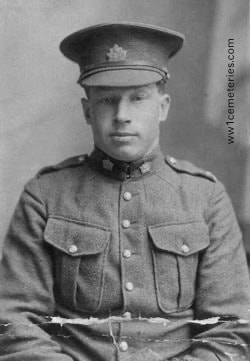
412062 Private
Joseph William Schooling
24th Bn. Canadian Infantry
5th July 1917, aged 26.
Plot I. G. 1.
Son of Mrs. H. Schooling, of Romford, England.
Joseph William Schooling
24th Bn. Canadian Infantry
5th July 1917, aged 26.
Plot I. G. 1.
Son of Mrs. H. Schooling, of Romford, England.
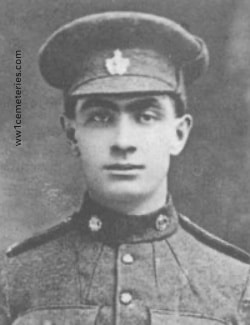
865917 Private
David Llewellyn Stouffer
8th Bn. Canadian Infantry
22nd January 1918, aged 19.
Plot I. R. 26.
Son of J. F. and Jennie Stouffer, of Holmfield, Manitoba.
His headstone bears the inscription "Asleep In Jesus"
David Llewellyn Stouffer
8th Bn. Canadian Infantry
22nd January 1918, aged 19.
Plot I. R. 26.
Son of J. F. and Jennie Stouffer, of Holmfield, Manitoba.
His headstone bears the inscription "Asleep In Jesus"
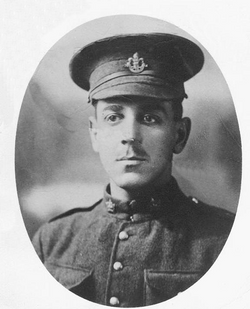
417544 Private
Omer Veziau
19th Bn. Canadian Infantry
15th August 1917.
Plot I. J. 20.
Omer Veziau
19th Bn. Canadian Infantry
15th August 1917.
Plot I. J. 20.
Shot at Dawn
448160 Private Gustave Comte, 22nd Bn. Canadian Infantry executed for desertion on 3rd July 1917, aged 22. Plot I. F. 20. 4 days after his arrival in the UK in June 1916, he was confined to the camp for a week for being unshaven on parade, the sentence being doubled the next day for being improperly dressed on parade. On 29 December, Comte was sentenced to Field Punishment No 1 for ‘irregular conduct whilst a sentry’ on Christmas Day. 4 days later, he went missing for 6 hours, resulting in a further 7 days' Field Punishment. In early April, prior to the assault on Vimy Ridge, he decamped again, being captured only in the following month. (Putkowski, pp. 176-177)
672604 Private Joseph LaLancette, 22nd Bn. Canadian Infantry, executed for desertion 3rd July 1917, aged 21. Plot I. F. 21. A slightly built man, a tailor in civilian life, he absented himself for a day when bound for entrenching work, & 2 days’ pay was docked. Just before Christmas 1916, he absented himself again from the trenches for a period of 4 hours, which resulted in Field Punishment for 14 days. Upon completion, he was taken ill — & went absent for the last time after he had recovered. He was executed along with his fellow-Canadian Pte Comte. (Putkowski, pp 177-178)
448160 Private Gustave Comte, 22nd Bn. Canadian Infantry executed for desertion on 3rd July 1917, aged 22. Plot I. F. 20. 4 days after his arrival in the UK in June 1916, he was confined to the camp for a week for being unshaven on parade, the sentence being doubled the next day for being improperly dressed on parade. On 29 December, Comte was sentenced to Field Punishment No 1 for ‘irregular conduct whilst a sentry’ on Christmas Day. 4 days later, he went missing for 6 hours, resulting in a further 7 days' Field Punishment. In early April, prior to the assault on Vimy Ridge, he decamped again, being captured only in the following month. (Putkowski, pp. 176-177)
672604 Private Joseph LaLancette, 22nd Bn. Canadian Infantry, executed for desertion 3rd July 1917, aged 21. Plot I. F. 21. A slightly built man, a tailor in civilian life, he absented himself for a day when bound for entrenching work, & 2 days’ pay was docked. Just before Christmas 1916, he absented himself again from the trenches for a period of 4 hours, which resulted in Field Punishment for 14 days. Upon completion, he was taken ill — & went absent for the last time after he had recovered. He was executed along with his fellow-Canadian Pte Comte. (Putkowski, pp 177-178)


